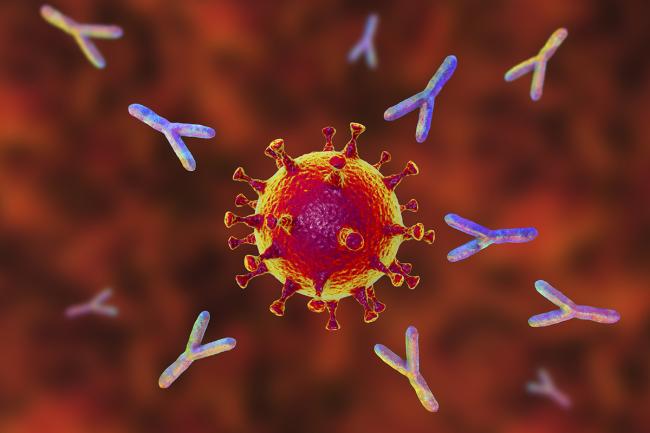Antibodies and T cells protect against SARS-CoV-2
December 15, 2020
Antibodies and T cells protect against SARS-CoV-2
At a Glance
- Monkeys with the highest levels of antibodies against SARS-CoV-2, the virus that causes COVID-19, were best protected against reinfection.
- Immune cells called T cells also helped prevent reinfection and may be especially important if antibody levels are low or decline over time.

The tide in the global fight against COVID-19, the disease caused by the SARS-CoV-2 virus, may soon begin to turn. Last month, three pharmaceutical companies announced promising results from vaccine trials. Countries around the world are now poised to begin the largest mass vaccination campaigns since the 1950s.
But some questions remain about what types and amounts of immune system components are needed to produce long-term immunity against SARS-CoV-2. This information would be valuable both for tracking the effectiveness of vaccines and designing new ones in the future.
Researchers led by Dr. Dan Barouch of Beth Israel Deaconess Medical Center used monkeys called rhesus macaques to look at levels of antibodies and immune cells required to prevent reinfection with the virus.
The study was funded in part by NIH’s National Institute of Allergy and Infectious Diseases (NIAID), Office of the Director (OD), and National Cancer Institute (NCI). Results were published on December 4, 2020, in Nature.
The research team first collected antibodies from rhesus monkeys that had been exposed to SARS-CoV-2 and recovered. When these antibodies were injected into unexposed monkeys, the monkeys were protected against later exposure to the virus. The level of protection matched the amount of antibody received. All three monkeys that were given the highest dose had no detectible virus in either their noses or lungs after exposure.
In contrast, only one out of three monkeys that received a medium dose of antibodies was completely protected. All three monkeys that received the lowest dose got infected, although the length of infection was shorter than in monkeys that weren't given any antibodies. Further modeling experiments estimated the minimum level of antibodies needed in blood to confer protection against the virus.
The team also tested the antibodies in monkeys that had already been infected by the virus. As in the experiments that used the antibodies to prevent infection, the highest dose proved to be most effective at reducing levels of the virus.
People who’ve been infected with SARS-CoV-2 usually can’t produce levels of effective antibodies like those used in the monkeys that received the highest dose. Therefore, engineered antibodies produced in the lab—called monoclonal antibodies—may be a better strategy than convalescent plasma for treating people, the results suggest.
Finally, the researchers tested whether immune cells called T cells play a role in long-term immunity to the virus. They used a drug to deplete T cells in five monkeys that had recovered from SARS-CoV-2, then re-exposed them to the virus. All had evidence of reinfection in the nose, and one had virus in its lungs. In contrast, monkeys with active T cells successfully fought off reinfection.
Antibodies initially produced by the body after infection had started to drop during this period. This finding suggests that T cells are needed for long-term protection from the virus.
“Antibodies alone can protect, including at relatively low levels, but T cells are also helpful if antibody levels are insufficient,” Barouch says. “Such knowledge will be important in the development of next generation vaccines, antibody-based therapeutics, and public health strategies for COVID-19.”
—by Sharon Reynolds
Related Links
- Hydroxychloroquine Doesn’t Benefit Hospitalized COVID-19 Patients
- Coronaviruses Hijack Lysosomes to Exit Cells
- Final Report Confirms Remdesivir Benefits for COVID-19
- Computer-Designed Proteins May Protect Against Coronavirus
- Potent Neutralizing Antibodies Target New Regions of Coronavirus Spike
- Potent Antibodies Found in People Recovered from COVID-19
- Llama Antibody Engineered to Block Coronavirus
- Novel Coronavirus Structure Reveals Targets for Vaccines and Treatments
- Coronavirus (COVID-19)
- Coronavirus Prevention Network
- Coronavirus (COVID-19) (CDC)


